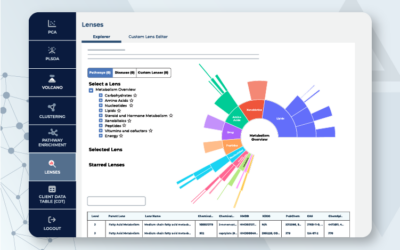Research documents the correlation between inflammation and disease states, ranging from Alzheimer’s disease to hypertension.1,2 A cellular-level analysis can offer insights into various disease pathogenesis related to inflammation in particular.2,3 Further, studies note lipids as mediators of such inflammation, making an understanding and detailed characterization of them important to the research of multiple disease states.2,4,5
Types of Lipids and Their Impact on Inflammation
The eight standard categories of lipids are comprised of glycerophospholipids (GP), glycerolipids (GL), fatty acyls (FA), polyketides (PK), prenol lipids (PR), saccharolipids (SL), sterol lipids (ST), and sphingolipids (SP).6,7
Additional subcategories of these classes exist with subcategories of their own. For example, within the initial fatty acyls (FA) class, there are multiple eicosanoid subclasses of lipids that impact inflammation, including pro-inflammatory mediators and anti-inflammatory mediators.2 In particular, sub-families of eicosanoids encompass the following: resolvins, protectins, maresins, endocannabinoids, prostaglandins, lipoxins, leukotrienes, thromboxanes, and isoprostanes, among others.2 Data note the role of eicosanoids in neuroinflammation, supporting the characterization of eicosanoids to further study the underlying causes of disease and design effective treatments.8
Eicosanoids and Alzheimer’s Disease
Alzheimer’s disease impacts 5.8 million Americans, and that number is on track to reach 14 million as soon as 2050, making an understanding of its underlying causes a focus of intense scientific study.2 Research documents eicosanoids’ role in inflammation as it contributes to the pathogenesis of Alzheimer’s disease.2 Bioactive signaling molecules, eicosanoids, result when polyunsaturated fatty acids (PUFAs) and arachidonic acid (AA) are oxidized.2
Further, research shows a correlation of eicosanoid metabolites with various stages of Alzheimer’s disease, including onset, progression, and resolution.2
Insights to Alzheimer’s Disease from Elevated Prostaglandins
Data document that, of the eicosanoids in the brain, prostaglandin D2 is most prevalent.2 Further, in disease states, prostaglandin D2 is also more abundant than other eicosanoids.9 However, additional study is required to comprehensively characterize prostaglandin’s role in Alzheimer’s disease as data conflict on its role in elevating or alleviating inflammation.2
Implications of Lipidomics for Disease State Research
Due to the increased focus of research on the role of lipidomics in disease pathogenesis, future studies can leverage lipidomics to drive further insights into several disease indications, including Alzheimer’s disease, among others.
With Metabolon’s growing global metabolomic reference library and validated panels, we are excited to contribute to your lipidomics research, helping you gain insights more quickly and ultimately get closer to understanding and combating many major diseases. Lipidomics is a fast-growing field of exploratory research, and we will continue to share our insights, along with new research, as discoveries are made.
Ready to see what new insights lipidomics can help your research reveal?
Contact us today to discuss your project or study.
References
- De Miguel C, Rudemiller NP, Abais JM, Mattson DL. Inflammation and hypertension: new understandings and potential therapeutic targets. Curr Hypertens Rep. 2015 Jan;17(1):507. doi: 10.1007/s11906-014-0507-z. PMID: 25432899; PMCID: PMC4418473.
- Biringer RG. The Role of Eicosanoids in Alzheimer’s Disease. Int J Environ Res Public Health. 2019 Jul 18;16(14):2560. doi: 10.3390/ijerph16142560. PMID: 31323750; PMCID: PMC6678666.
- Solito E., Sastre M. Microglia function in Alzheimer’s disease. Front. Pharmacol. 2012;3 doi: 10.3389/fphar.2012.00014.
- Kubicek-Sutherland JZ, Vu DM, Mendez HM, Jakhar S, Mukundan H. Detection of Lipid and Amphiphilic Biomarkers for Disease Diagnostics. Biosensors. 2017; 7(3):25. https://doi.org/10.3390/bios7030025.
- Li F,Prestwich GD. Functional Lipidomics; CRC Press: Boca Raton, FL, USA, 2005; p. 2.
- Fahy E, Subramaniam S, Murphy RC, Nishijima M, Raetz CRH, Shimizu T, Spener F, Meer G, Wakelam MJO, Dennis EA. Update of the LIPID MAPS comprehensive classification system for lipids. Journal of Lipid Research 50 (2009) S9-S14. doi: https://doi.org/10.1194/jlr.R800095-JLR200. 10.1194/jlr.R800095-JLR200
- Addepalli RV, Mullangi R. A concise review on lipidomics analysis in biological samples. ADMET DMPK. 2020 Dec 9;9(1):1-22. doi: 10.5599/admet.913. PMID: 35299875; PMCID: PMC8923307.
- Tassoni D., Kaur G., Weisinger R.S., Sinclair A.J. The role of eicosanoids in the brain. Asia Pac. J. Clin. Nutr. 2008;17(Suppl. 1):220–228.
- Liang X, Wu L, Hand T, Andreasson K. Prostaglandin D2 mediates neuronal protection via the DP1 receptor. J. Neurochem. 2005;92:477–486. doi: 10.1111/j.1471-4159.2004.02870.x.





